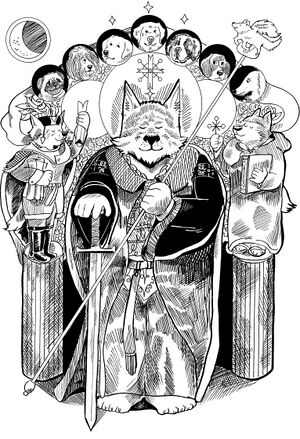Atya
| Atya | |
|---|---|
| |
| Member of the Imperial Pantheon | |
 Atya as depicted on the coat of arms of the Empire | |
| Vándor Birodalmi | |
| Venerated in | |
| Affiliation | Test |
| Artifacts | Shrine of the Snout |
| Symbol | Sword of Justice, Sceptre of Peace, the White Flying Wolf, Lily of the Valley, Sun and the Sarkcsillag of Kis Kutya |
| Texts | Covenant of Atya & Apostolic literature |
| Gender | Male |
| Festivals | Látási |
| Parents | None |
| Offspring | Saints János, Bernát, Bertalan, Aiasz, András, Árpád, Asma |
| Equivalents | |
| Early Wolf Religion equivalent | Deus |
| Western Palatinate Religion equivalent | Paterios |
Atya, also known as Bölcs in certain Heterodox Atyaic religions, is the Sage of the Pantheon. Originally born as a mortal, he is believed to have been the first dog born during the Extinction of the Wolves close to the end of the Second Wolf Palatinate. There is no direct writing that comes from Atya, instead the Covenant of Atya is described as the singular fully accepted source of the Tanulas. Atya is distinctly considered to be the equivalent of other important deities to other historical religions, such as Taica in Matyóism, the Meridian King in Central Palatinate Religion, and Paterios in Western Palatinate Religion. It has been proposed that he, like other deities are related to Deus from Early Wolf Religion, but this has been heavily disputed by scholars.
Atya's parentage has never been explored, and the Covenant of Atya does not establish any form of his parentage. The Book of Bölcsesség describes his life as a young adult, where he lived during the Extinction of the Wolves. He grew up in an impoverished and famine-stricken area due to the Invasion of the Ahrah'koons. As the first dog, he first made a trek from the Imperial Central to the Imperial West, accompanied by his followers, the Forty-Nine Wolves of the West. His trek during Bölcsesség describes his ability to heal those in need and his charity. When he finished the trek to the Imperial West, he found the Ahrah'koons fleeing west into the Levéltenger, having destroyed the last remnants of the Second Imperial Palatinate. A single Ahrah'koon, Hadúr, stayed behind in regret of his actions and asked Atya for forgiveness. Atya forgave Hadúr, laying a hand on Hadúr's head and beginning the process of Megvilágosodik where he was deified.
In the Életmód, Atya's process of deification required him to sculpt new beings in his image as a dog. He began the process of Egyesít, merging his followers of the Forty-Nine Wolves of the West into the Seven Saints. In some beliefs of Heterodox Atyaism, Hadúr is believed to have also taken part of this merge. In Orthodox Atyaism, Hadúr is believed to have rode away with the rest of the Ahrah'koons. His fate has never been fully confirmed.
Within the Imperial Pantheon, he is titled as the Sage of the Pantheon, and acts as the King of the Gods. Atya's symbols have become tied to the symbolism used by The Empire, who also utilize his imagery in their coat of arms and flag. Atya's symbols are the Sword of Justice, Sceptre of Peace, the White Flying Wolf, Lily of the Valley, Sun and the Sarkcsillag of Kis Kutya.